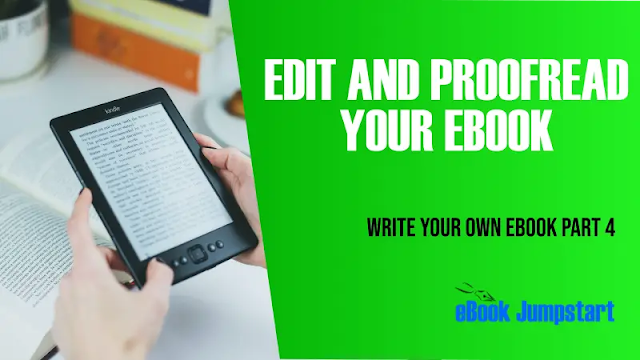- Why do you proofread your ebook draft?
- What is the recommended process of proofreading?
- What are typical first draft errors to look for?
- How to keep track of errors found in proofreading
- What happens after proofreading is complete?
- Edit and proofread your ebook - Conclusion
Why do you proofread your ebook draft?
A lot of ebook creators skip this process as they are not concerned about the quality they provide their readers. These are mostly authors who create ebooks solely for the purpose of free giveaways in order to build their email lists.If you want to create eBooks as an income stream this is a very important part of creating a quality eBook.
Proofreading your draft ebook is essential for several reasons:
Improving readability
A well-proofread ebook is easier to read and understand, which can improve your readers' overall experience.
Increasing credibility
Typos, misspellings, and grammatical errors can detract from the professionalism of your work and harm your author's credibility. Proofreading ensures that your ebook is polished and free of errors.
Increasing accuracy
Proofreading helps you catch factual errors and inconsistencies in your writing, which can improve the accuracy of your information and strengthen your arguments. It is also a good way of verifying the topic research you have done when you started.
Building a positive reputation
By publishing a high-quality ebook, you can establish yourself as an expert in your field and build a positive reputation as an author.
Avoiding confusion
Errors in your ebook can perplex your readers and hinder their comprehension of your message. Proofreading ensures that your ebook is clear, concise, and simple to read.
In a nutshell, proofreading is an important step in the ebook creation process because it allows you to create a polished, professional, and accurate final product. You can ensure that your ebook is the best it can be and that your readers receive the quality content they expect from you by devoting time and effort to proofreading.
What is the recommended process of proofreading?
Every writer will develop their own proofreading process because it takes time. You will also find a method that is most suitable for your writing style.
The following is the recommended procedure for proofreading a draft copy:
Take a break
Before you begin proofreading your draft, take a break from writing to allow your mind to clear. This will allow you to approach proofreading with fresh eyes.
Read it backward
Begin at the end of your draft and work your way through it, sentence by sentence. This can assist you in catching errors such as typos and grammatical errors that you may have missed previously.
Read it aloud
Reading your draft aloud can help you catch awkward phrasing, missing words, and other mistakes. You can also convert it online with text-to-speech software and then listen to it.
Use a spell-checker
Most word-processing programs include a spell-checker. It can be used to detect spelling and typos.
Check your grammar
Grammar check tools can assist you in identifying and correcting grammar mistakes. I personally use this for two reasons - saving time and I am not too good with English grammar.
Allow someone else to read it
Another set of eyes can spot mistakes and provide a fresh perspective on your work. Proofread your draft with the help of a friend, family member, or professional editor. If you have no one to read this then convert it online from text to speech then listen to it.
Make a copy
Reading a physical copy of your draft can sometimes help you spot errors that you may have missed on a screen.Review the big picture
After you've finished proofreading, take a step back and look at the overall structure and flow of your draft. Make sure your content is organized and your ideas are clear and concise.
Remember that proofreading is an iterative process, and it's normal to require multiple rounds of revisions to get your draft in tip-top shape. Don't be afraid to make changes, and don't be discouraged if you discover errors—everyone makes mistakes, and the goal is to catch and correct them before publishing.
What are typical first draft errors to look for?
As with anything else in life, there are some errors that every writer is guilty of so why not draw from experience.Here are some common errors to look for when proofreading your first draft:
Typos and misspelled words
These are errors that a spell-check tool can easily detect.
Grammar mistakes
These include subject-verb agreement, verb tense, and other grammatical errors. To help identify these errors, use a grammar check tool or have someone else read your draft.
Awkward sentence structure and phrasing
This includes sentences that are too long or too short, or that do not flow well. Read your draft aloud to help you spot these mistakes.
Inconsistent formatting
Make sure that your formatting is consistent throughout your draft, such as headings, font styles, and spacing.
Factual errors
Double-check your facts, including dates, names, and locations, to ensure they are correct.
Repetition
Look for places in your draft where you might be repeating yourself and consider deleting or rephrasing those sections.
Passive voice
Using passive voice in your writing can make it appear less direct and engaging. Look for examples of passive voice and rephrase in an active voice.
Inconsistent point of view
If you're writing in the first person, make sure you keep that point of view consistent throughout your draft. If you're writing in the third person, make sure you're using the third person consistently.
These are just a few of the common mistakes you may come across when proofreading your first draft. The goal is to catch as many of these errors as possible so that you can make changes and create a polished, error-free final product.

How to keep track of errors found in proofreading
It is important to keep track of the errors that you have found and changed because if there are many it can change the context of your content. You might want to come back later and revert to the original.There are several methods for keeping track of errors discovered during your proofreading:
Track changes
If you're using a word processing program, you can keep track of your edits and revisions by using the "Track Changes" feature. This allows you to see what changes have been made and easily revert to a previous version if necessary.
Highlighting errors
Errors can be highlighted or underlined with a highlighter or pen if you're reading a physical copy of your draft.
Make a list of everything
Create a list of all the errors you find in your draft if you prefer to keep track of them in a separate document. This list can help you keep track of which errors you've fixed and which you still need to fix.
Use comments
If you're using a word processor, use the comment feature to leave yourself notes about the errors you've discovered.
Take notes
If you're reading a physical copy of your draft, keep track of the errors you find on a separate sheet of paper.
The most important thing, no matter which method you use, is to keep track of the errors you find in a way that works for you. This will help you stay organized and speed up the proofreading process.
What happens after proofreading is complete?
Ok, you have done the proofreading, and now what? Most creators will at this stage go on and publish. Finding mistakes after publishing is common and takes a long time to rectify so it is better to make sure everything is the way it is supposed to be before continuing.Following the proofreading and correction of errors in your draft, you should take the following steps:
Examine your changes
Examine your draft one more time to ensure that all of the changes you made are accurate and make sense in the context of your writing.
Save your final draft
When you're finished making changes, save your final draft in a safe and easily accessible location. If you need to access it later, save a copy in multiple formats, such as a word processing document and a PDF.
Get feedback
If you want to get feedback on your final draft, consider sharing it with beta readers. These are the people who will read your draft and comment on its content, structure, and overall impact.
Consider hiring an editor
If you want a professional opinion on your draft, think about hiring an editor. An editor can provide a thorough critique of your writing as well as suggestions for improvement.
There are many freelancers available on platforms such as Fiverr that will do it for a reasonable fee. Hiring a trustworthy and competent one will take some investigation on your part though.
Publish
Once you're happy with your final draft, you can turn it into an ebook. You can publish it on well-known platforms like Amazon Kindle Direct Publishing, Smashwords, or other direct publishing platforms.
Market and promote
After you've published your ebook, you'll need to market and promote it in order to reach a larger audience. To reach potential readers and generate buzz for your ebook, you can use social media, book blogs, and other marketing channels.
Remember that publishing an ebook is only the first step. To reach your target audience and achieve success as an author, you'll need to keep working hard to market and promote your work.
Edit and proofread your ebook - Conclusion
Proofreading is an essential step in the creation of a successful ebook. It entails going over the draft carefully to catch typos, grammatical errors, awkward phrasing, inconsistent formatting, and other common errors.You can keep track of the errors you find by using track changes, highlighting, making a list, using comments, and taking notes.
After proofreading and revising, it's critical to go over your changes, save your final draft, share it with beta readers for feedback, think about hiring an editor, and finally publish and market your ebook.
Proofreading is an important step in the ebook creation process because it ensures that the final product is polished and error-free.
Learning how to create good quality eBooks is an important part of any online income stream you will be creating going forward.



.webp)









0 Comments
Thank You for your comment and please visit again. Comment will appear after moderation.
Emoji